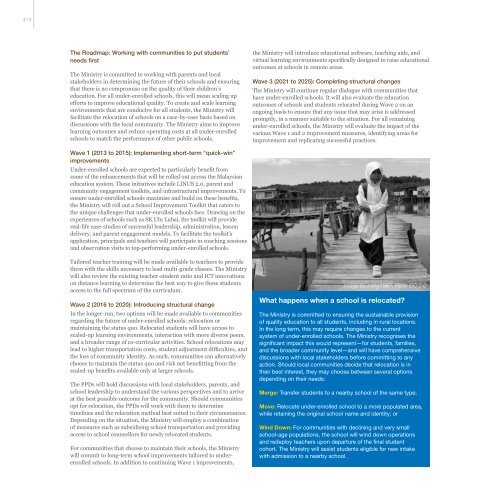Preliminary-Blueprint-Eng
Preliminary-Blueprint-Eng
Preliminary-Blueprint-Eng
You also want an ePaper? Increase the reach of your titles
YUMPU automatically turns print PDFs into web optimized ePapers that Google loves.
4-13<br />
the roadmap: Working with communities to put students’<br />
needs first<br />
The Ministry is committed to working with parents and local<br />
stakeholders in determining the future of their schools and ensuring<br />
that there is no compromise on the quality of their children’s<br />
education. For all under-enrolled schools, this will mean scaling up<br />
efforts to improve educational quality. To create and scale learning<br />
environments that are conducive for all students, the Ministry will<br />
facilitate the relocation of schools on a case-by-case basis based on<br />
discussions with the local community. The Ministry aims to improve<br />
learning outcomes and reduce operating costs at all under-enrolled<br />
schools to match the performance of other public schools.<br />
Wave 1 (2013 to 2015): implementing short-term “quick-win”<br />
improvements<br />
Under-enrolled schools are expected to particularly benefit from<br />
some of the enhancements that will be rolled out across the Malaysian<br />
education system. These initiatives include LINUS 2.0, parent and<br />
community engagement toolkits, and infrastructural improvements. To<br />
ensure under-enrolled schools maximise and build on these benefits,<br />
the Ministry will roll out a School Improvement Toolkit that caters to<br />
the unique challenges that under-enrolled schools face. Drawing on the<br />
experiences of schools such as SK Ulu Lubai, the toolkit will provide<br />
real-life case-studies of successful leadership, administration, lesson<br />
delivery, and parent engagement models. To facilitate the toolkit’s<br />
application, principals and teachers will participate in coaching sessions<br />
and observation visits to top-performing under-enrolled schools.<br />
Tailored teacher training will be made available to teachers to provide<br />
them with the skills necessary to lead multi-grade classes. The Ministry<br />
will also review the existing teacher-student ratio and ICT innovations<br />
on distance learning to determine the best way to give these students<br />
access to the full spectrum of the curriculum.<br />
Image by DMahendra, Flickr CC 2.0<br />
Wave 2 (2016 to 2020): introducing structural change<br />
In the longer-run, two options will be made available to communities<br />
regarding the future of under-enrolled schools: relocation or<br />
maintaining the status quo. Relocated students will have access to<br />
scaled-up learning environments, interaction with more diverse peers,<br />
and a broader range of co-curricular activities. School relocations may<br />
lead to higher transportation costs, student adjustment difficulties, and<br />
the loss of community identity. As such, communities can alternatively<br />
choose to maintain the status quo and risk not benefitting from the<br />
scaled-up benefits available only at larger schools.<br />
The PPDs will hold discussions with local stakeholders, parents, and<br />
school leadership to understand the various perspectives and to arrive<br />
at the best possible outcome for the community. Should communities<br />
opt for relocation, the PPDs will work with them to determine<br />
timelines and the relocation method best suited to their circumstances.<br />
Depending on the situation, the Ministry will employ a combination<br />
of measures such as subsidising school transportation and providing<br />
access to school counsellors for newly relocated students.<br />
For communities that choose to maintain their schools, the Ministry<br />
will commit to long-term school improvements tailored to underenrolled<br />
schools. In addition to continuing Wave 1 improvements,<br />
the Ministry will introduce educational software, teaching aids, and<br />
virtual learning environments specifically designed to raise educational<br />
outcomes at schools in remote areas.<br />
Wave 3 (2021 to 2025): Completing structural changes<br />
The Ministry will continue regular dialogue with communities that<br />
have under-enrolled schools. It will also evaluate the education<br />
outcomes of schools and students relocated during Wave 2 on an<br />
ongoing basis to ensure that any issue that may arise is addressed<br />
promptly, in a manner suitable to the situation. For all remaining<br />
under-enrolled schools, the Ministry will evaluate the impact of the<br />
various Wave 1 and 2 improvement measures, identifying areas for<br />
improvement and replicating successful practices.<br />
Image by ming1967, Flickr CC 2.0<br />
What happens when a school is relocated?<br />
The Ministry is committed to ensuring the sustainable provision<br />
of quality education to all students, including in rural locations.<br />
In the long term, this may require changes to the current<br />
system of under-enrolled schools. The Ministry recognises the<br />
significant impact this would represent—for students, families,<br />
and the broader community level—and will have comprehensive<br />
discussions with local stakeholders before committing to any<br />
action. Should local communities decide that relocation is in<br />
their best interest, they may choose between several options<br />
depending on their needs:<br />
Merge: Transfer students to a nearby school of the same type;<br />
Move: Relocate under-enrolled school to a more populated area,<br />
while retaining the original school name and identity; or<br />
Wind down: For communities with declining and very small<br />
school-age populations, the school will wind down operations<br />
and redeploy teachers upon departure of the final student<br />
cohort. The Ministry will assist students eligible for new intake<br />
with admission to a nearby school.


